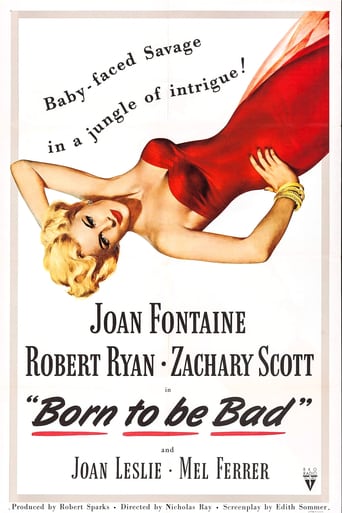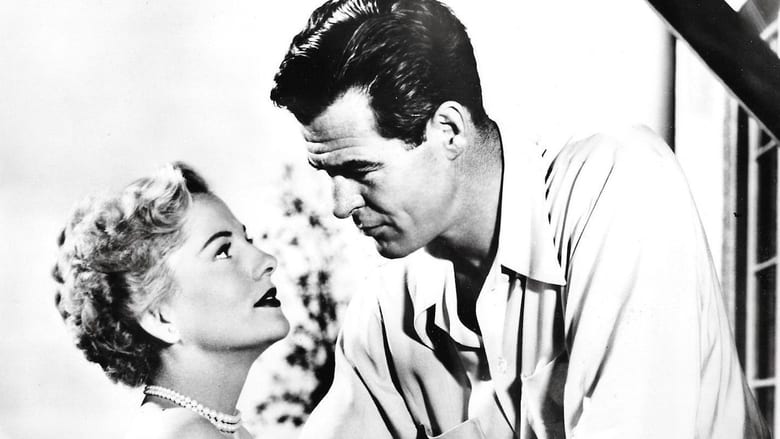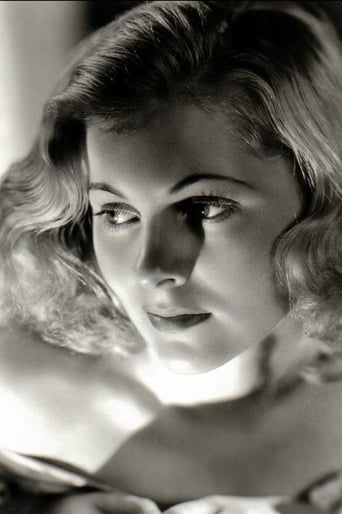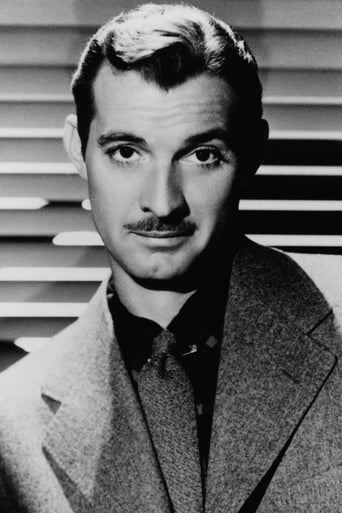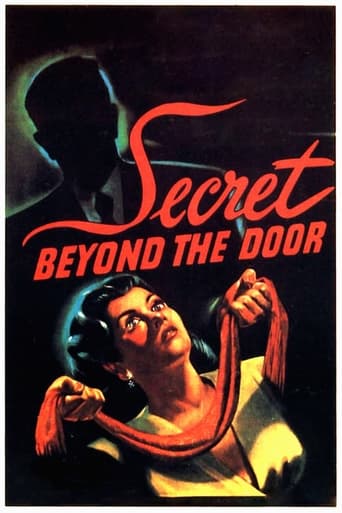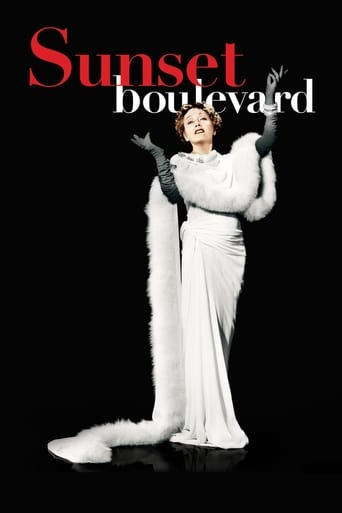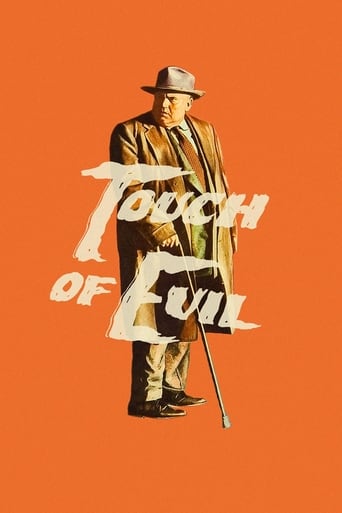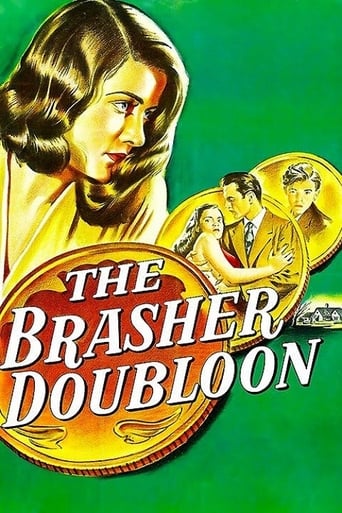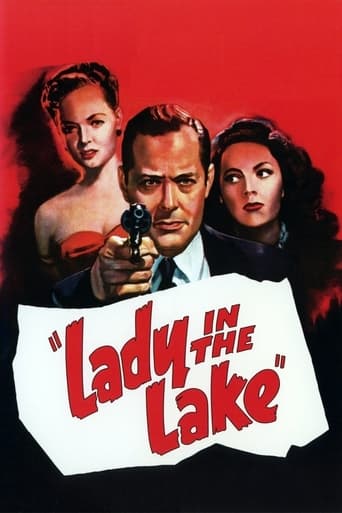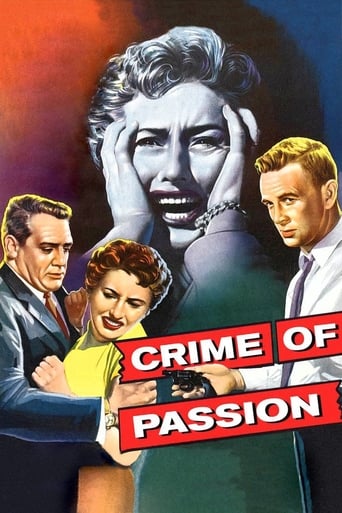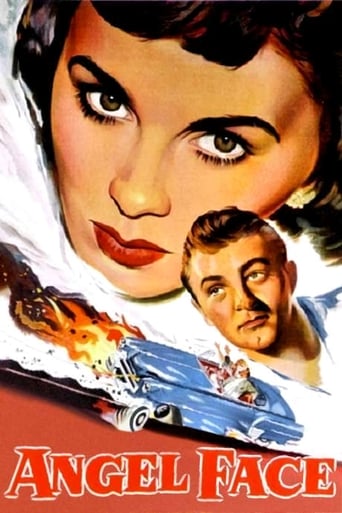Born to Be Bad (1950)
Christabel Caine has the face of angel and the heart of a swamp rat. She'll step on anyone to get what she wants, including her own family. A master of manipulation, she covertly breaks off the engagement of her trusting cousin, Donna, to her fabulously wealthy beau, Curtis Carey. Once married to Curtis herself, Christabel continues her affair with novelist Nick Bradley, who knows she's evil, but loves her anyway.
Watch Trailer
Cast


Similar titles
Reviews
Fantastic!
In truth, there is barely enough story here to make a film.
This is one of the few movies I've ever seen where the whole audience broke into spontaneous, loud applause a third of the way in.
The movie's neither hopeful in contrived ways, nor hopeless in different contrived ways. Somehow it manages to be wonderful
. . and incites this humble reviewer to an extended rhapsody.'Born to Be Bad' is yummy fun for film buffs, fans of Joan Fontaine, film noir and Nick Ray, as well as students of Gay history. Released the same year as 1950's 'All About Eve', with a similar theme: scheming wallflower breezes into town and proceeds to steal another woman's fabulous life.Here the setting is not the Broadway crowd, but a subtler, more spacious and brightly-lit counterpart in the cosmopolitan circles of post-WWII San Francisco. You got the richest (and most naive) young man in town, his erstwhile capable fiancée, their snappy-mercenary gay artist pal, a hyper-hetero rough young novelist on the verge of fame, and his diminutive high-power agent -- who invites his poor-relation niece into the mix, who -- wham-bam -- proceeds to s - - t all over everything and everybody.Fascinating to watch Joan play against type as Christabel -- the actress's natural sweetness here contextualized as pure ruthless artifice as she smarms her way to the top. Nobody's terribly nice to anybody else in this film anyway (even the minor characters and extras throw continuous shade), thus, as in 'All About Eve', their less-than-saintly, less-than-solid society is vulnerable to invasion by an ambitious nobody -- who needs do little more than strategically scratch the surface in order to prevail. Juicy, fun cinema of manners! Nobody's fooled by the interloper for very long -- all but her wealthy target are on to her from nearly the start -- but for a variety of reasons: from not wanting to appear unseemly, to raw self-interest -- everybody lets her get away with it. Messy, messy -- just like life. Joan Leslie as the wronged woman is particularly effective at conveying the helplessness of an otherwise savvy and capable person caught in the cross-hairs of an expert predator.Mel Ferrer as the gay artist Gabby (short for Gabriel, which he insists everybody pronounce affectedly as 'Gahbby') is worth noting, in the kind of role usually given to professional crypto-gay aesthete types like Clifton Webb -- suitably neutered by convention so as not to suggest carnality. Ferrer on the other hand is here a butch, young, handsome actor of considerable masculine sex appeal, not to say talent. (Ferrer would later marry and guide the career of Audrey Hepburn.) He's given genuinely-funny bitchy epigrams throughout, and several flat-out declarations of his orientation, albeit in the usual euphemistic language required in that time -- yet, apart from a charming too-graceful hand gesture and giggle in his first scene, Ferrer wisely avoids any hint of camp effeminate stereotype -- he just lets himself be a serious guy running his business who happens to be openly gay -- a singularly revolutionary thing in film at that time, and still elusive in film today.Ferrer's brief scenes with Robert Ryan as the 'lady-killer' man's man, and Zachary Scott as the rich 'sap', indicate that straight guys think he's a fine fellow and enjoy long-term friendships with him, and suggest a couple of other things: Ferrer when sharing the screen with Scott and Ryan, appears equally fit and young, i.e., sexually viable. Zachary Scott's passive softness and his own sometime crypto-gay actor's image cause one particular moment between Ferrer and Scott to speak of a possible personal history beyond friendship. The three of them represent male archetypes, benchmarks on the Kinsey male sexuality scale: hard hetero, in-between, and strickly-d- - -ly, with Joan's 'rich Uncle John' the literary super-agent thrown in, who for all appearances is a self-made gay man sublimating his sexuality into his work. Joan also must escape the passive-aggressive meddling of her countrified cloying 'Aunt Clara', the archetypal 'spinster' cinematic crypto-lesbian.It's that kind of movie -- subtext, subtext, subtext -- or why Nick Ray matters! As with other masters -- Douglas Sirk and Michael Powell come to mind -- nothing in the frame is ever there by accident. Ray's cinematic language to convey, within 1950 restrictions, when illicit sex acts actually take place in the story -- which is often -- is so raw and original one feels the need for a hot bath afterward, as Joan's character in fact does at one suspenseful point. Robert Ryan deserves much credit for this -- his character is unapologetically bestial -- a priapic satyr -- practically swallowing Joan whole in every scene they are in together.The DVD I saw included an alternative ending in the extras. It has its good points, additional tawdry humor, etc. Recommended. (Glad they went with the one they went with though.)
With a long camera closeup lingering on her, you know that sweet looking Joan Fontaine is truly trouble. With the soap opera sounding name of Christabel Kane, Fontaine could be the aunt that Erica Kane of "All My Children" picked up a thing or two from. In fact, the whole plot line has a soap opera plot set up: distant relative Fontaine showing up at the home of Joan Leslie's, expected a day later, and passive aggressively setting up her scheming from the moment Leslie finds her sitting in her living room.Between the two women and three men (Robert Ryan, Zachary Scott and Mel Ferrer), there's enough soapy plot to fill an entire afternoon. Fontaine had played vixens before, but no one like Christabelle. Her murderess in "Ivy" was a period femme fatale, basically the American version of a Margaret Lockwood character, so in modern dress, she gets to be openly a modern women, basically a sort of Eve Harrington type schemer breaking into society rather than theater.The anti-hero bad boy, Robert Ryan, sees through her from the start, but is intrigued by her two sides. But if homewrecker has a picture in the dictionary, Fontaine's likeness in character should be there as she sets her eyes on Leslie's fiancée (Zachary Scott), with a painting by Mel Ferrer opening his eyes about her, and not taken in by her lady like facade. This goes for the gold as a camp classic, quite over the top, especially when Ryan refers to her painting as a cross between Lucretia Borgia and Peg o my heart.As for Leslie, she has a major makeup call as she's brought to life by the revelation of who this dangerous vixen really is and how she became the hand that not only rocked the cradle, but cracked it as well. Psychological darkness of the soul even opens the eyes of the amoral men, making this one of the few film noir where no crime is committed. Like the same named Erica Kane of daytime legend, God help any woman who gets any more male attention than her.
Who does 33 year old Joan Fontaine think she's fooling, playing a business college student? Other than that incredulity, and the fact that others are so easily manipulated by her seemingly inconsequential acts and words, she plays a conniving bitch to rival Anne Baxter's title character in that year's All About Eve (1950), though Fontaine's cute little smiles and feigned (yet knowing) look- asides will wear on most viewers as the movie progresses. There is lots of great dialogue, mostly one-liners by Robert Ryan's character like "I love you so much I wish I liked you", but there is absolutely no subtlety.Directed by Nicholas Ray, with an adaptation by Charles Schnee and a screenplay by Edith Sommer from an Anne Parrish novel with additional dialogue provided by George Oppenheimer and Robert Soderberg, this less than credible though highly watchable drama features Fontaine as Christabel, the niece of publisher John Caine (Harold Vermilyea), who comes to live with Caine's employee Donna Foster (Joan Leslie) while going to business college in San Francisco. She proceeds to ruin Donna's engagement to the family wealthy Curtis Carey (Zachary Scott) by planting seeds of doubt that his fiancée is a gold-digger.Meanwhile, Christabel is irresistibly drawn to writer come author Nick Bradley (Ryan!) - the two have an illicit affair while she disposes of Donna (who leaves for London) and simultaneously hooks Curtis for herself. Mel Ferrer plays Gobby, a non-judgmental third party witness to the goings-on, a painter who manages to hobnob with these wealthy persons as their friend despite his lack of financial means; he oozes just enough charm to have them pay his way into their group. Christabel had grown up living modestly with her Aunt Clara (Virginia Farmer), Caine's sister. Bess Flowers plays an untypical, credited role, Mrs. Worthington; Kathleen Howard plays a philanthropist, Mrs. Bolton. Irving Bacon plays a jewelry salesman.Of course, after Christabel has Curtis, or at least his money, she avoids him until Nick comes back in town ... but he's a stand-up guy who refuses to fool around with a married woman! Obviously she's found out in time for a contrived happy ending.
Nicholas Ray was famous for strong character-driven drama, and Born To Be Bad was no exception. Joan Fontaine was well cast against type as the sweetly scheming Christabel, a ladder-climber come hither who inserts herself into the lives of rich guy Zachary Scott and his fiancé Joan Leslie. Meanwhile, author Robert Ryan enters the scenario as does painter Mel Ferrer, who together provide an interesting juxtaposition to the idleness of rich folk depicted by Scott and eventually Fontaine. Fontaine successfully depicts a manipulator out for her own benefit, although she may appear too meek for some viewers' tastes. However, part of being able to skillfully manipulate includes being a good actress and masking one's true intentions. This reviewer recently met the acquaintance of just such a manipulator.Scott takes a while to catch on, but he delivers an appropriate response when he does. Leslie has perhaps the most difficult role of the woman set aside who maintains her dignity. Her return, while eagerly met by Scott, does not entirely ring true, since Scott let her leave without wavering earlier. In fact, Scott probably does not deserve Leslie. Ryan adds the most interesting character to the film as an author who falls hard for Fontaine but realizes what he's getting into in the process. An argument could be made between the four principle actors/actresses that Ryan is the most morally honest character in the film. Ryan also has some of the best lines. Ferrer adds little as the painter of Fontaine's portrait who may have recognized her for who she was all along. Much has been made regarding Ferrer's gayness, but it really does not matter much in the context of the film and may even be portrayed in stereotypical fashion.The film was probably ahead of its time in its frank portrayal of the amoral Fontaine, but the film does not add up to much and is remembered mainly as a passable melodrama. The ending is especially not satisfying, as is often the case for these types of films. Scott gets Leslie when he does not deserve her. Fontaine crassly leaves with armfuls of furs, despite maintaining the facade of politeness to Ferrer's painter character, who takes back his portrait of her thinking the value increased significantly because of the scandal created. Interesting device used in that Ferrer's character paints likenesses/portraits/facades while Fontaine's character maintains a facade at all times. The film was famously spoofed in a sketch on "The Carol Burnett Show" many years later. **1/2 stars.

